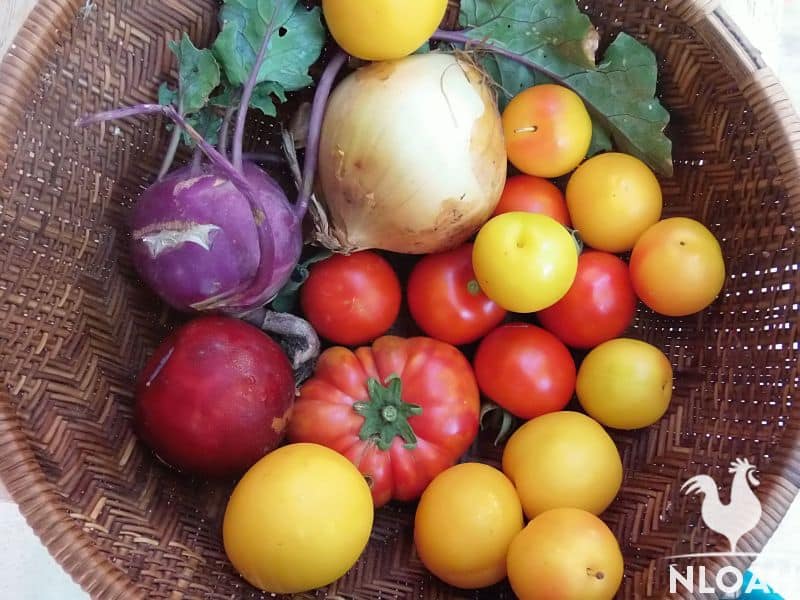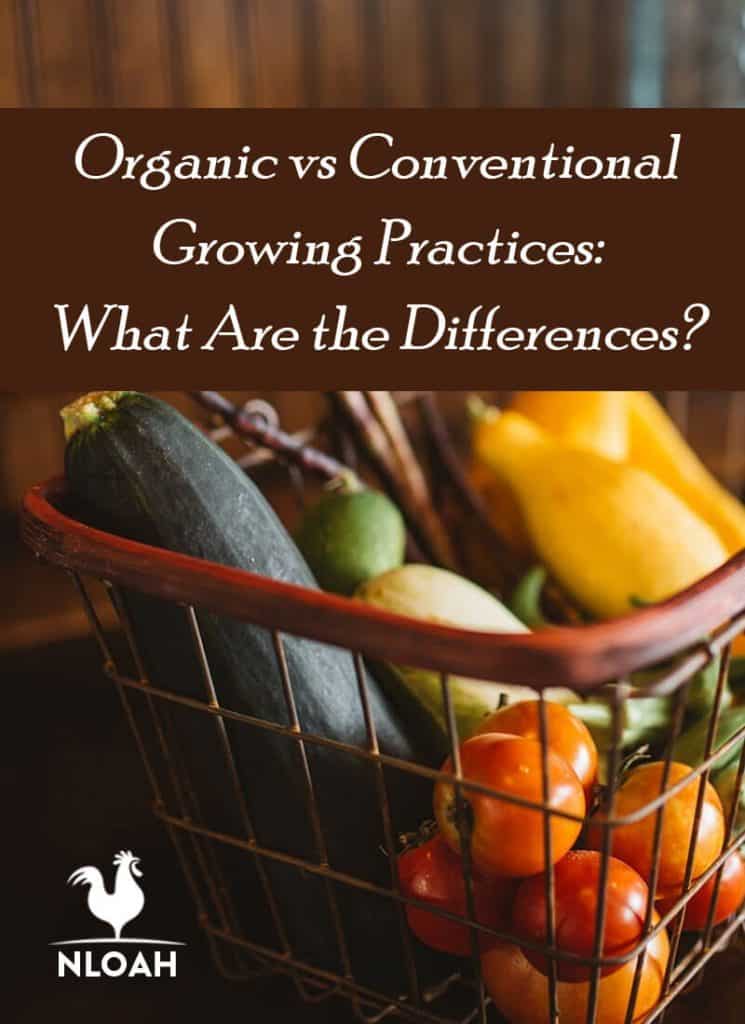When you first start gardening, you may ask yourself whether growing organic food is worth it, or if you would be better off sticking to more conventional growing practices. As a consumer, you may ask yourself the same question, wondering whether purchasing organic produce or other food is worth the (substantial) extra cost.
However, there are several key differences between organic and conventional growing practices that you need to consider – many of which can have a serious impact on your health and the health of the environment around you. Consider these key differences between conventional and organic growing practices as you are making the change in your garden.

Attention to Soil Health
As a farmer, it’s important that you pay attention to the health of the soil supporting your plants. It may seem like an inactive entity, but in reality, soil is teeming with microbes and other beneficial creatures, like earthworms, who turn and work the dirt almost constantly.
Without these beneficial microorganisms, your soil becomes stagnant. It does not have adequate nutrient contents or oxygen flow, and it can’t support healthy plant life, either. Therefore, it is of the utmost importance to maintain soil health so that you can grow vivacious plants.
Unfortunately, conventional growing practices like tilling and plowing have the effect of killing off these microorganisms, making it more difficult for your soil to support life. Many organic farmers use a no-till method of agriculture to kill weeds and to get the garden ready for planting.
As an organic farmer, you might use a mulch to kill perennial weeds, suffocating them while preserving the integrity of your soil. Too much cultivation disturbs soil life and causes compaction, killing those valuable microorganisms and depleting nutrients. This no-till method favored by many organic gardeners is a way to improve environmental quality while keeping the soil active and healthy.
Use of Genetically Modified Crops
GMOs, or genetically modified crops, are breeding techniques that utilize biotechnology to transfer genes directly into a plant.
These methods are designed to help make plants more resistant to disease, pests, and other stressors, but can be dangerous in that they promote large-scale monocultures and the development of superpests and superweeds that cannot be controlled.
Instead of using genetically modified crops, organic growers tend to turn to old-fashioned techniques like selective breeding and crop rotation to preserve the integrity and productivity of their plants.
Crop rotation helps to replenish the soil, as different plants deplete and then replenish different nutrients to the soil. This practice also helps to keep down the populations of insect pests and weeds, all of which cohabitate differently (or are attracted differently) with certain plants.
Weeding
Conventional growing practices typically rely on herbicides to control weeds. While these chemicals are effective at getting rid of unwanted plants, they have to be applied in a very targeted, timely fashion to avoid killing the desired plants.
In addition, like other chemicals used on the soil, they have a tendency to kill or otherwise harm beneficial microorganisms. They deplete soil health over time, making it more difficult for valuable crops to survive.
Organic farmers recognize that what you put on the soil has a long-term impact on it, so they rely on other strategies to cut down on weeds. For example, they might utilize hand weeding or other methods of mechanical weed control.
They use mulches and cover crops to choke out weeds, and plant crops in rotation to prevent attracting more stubborn and tenacious weed species. They plant densely to give weeds little room to survive.
Beneficial Insects and Pollinators
Organic farmers don’t turn to GMO cross pollination or pesticides to help keep plants pollinated or keep pests at bay. Instead, they look at more natural methods of keeping damaging bugs out of the garden, preferring instead to introduce beneficial insects that can pollinate their plants and eat harmful insects.
For example, ladybugs, green lacewings, nematodes, and soldier beetles are common choices for organic gardens.
These insects do not harm the plants, but eat the ones that do. There are no side effects to the introduction of these insects, and they help contribute to the natural circle of life within the garden.
Honey bees and monarch butterflies are popular pollinators for organic gardens, with many organic farmers choosing to raise honey bee hives or to set up habitats that are attractive to these pollinators to help encourage them to visit.
In many cases, organic farmers plant perennials or erect other attractants to draw in birds to help get rid of pests, too.
Designation of Buffer Zones
Organic farmers tend to designate the very edges of their land as buffer zones. Buffer zones essentially provide dedicated areas of the garden to prevent contamination. They conserve natural resources, and prevent your organic produce from being contaminated by pesticides or herbicides used on neighboring farms.
The theory behind them is simple. You can control the growing practices used on your farm, but what about those on neighboring farms? You might think that what your neighbor is doing doesn’t affect you, but that’s not the case.
Wind, pollinators, and water runoff can all travel to your farm, making it easy for your organic plants to be contaminated by the growing practices of another farm. Even pollution stemming from truly uncontrollable origins – such as salt use on the highways – can affect your plants and make them not truly organic.
This is where the concept of the buffer zone comes in. If there is any risk of contamination from nearby activities or adjacent properties, from pesticide applications to roadway runoff, you can construct a buffer zone that your produce can still be represented as organic. Buffer zones protect your crops from dangerous substances and exclusive methods of conventional farming like GMO cross-pollination.
There is no one-size-fits-all method of creating buffer zones – they just need to do their job. Organic farmers take into consideration things like wind patterns, land slope, stormwater drainage patterns, and the application of chemicals nearby.
The buffer zone can be of any size, but what’s more important is that the farmer takes into consideration a planting and management plan (with factors like heights of hedgerows and plant densities in mind). This will help prevent contamination and to protect your organic produce.
It’s important to note that buffer zones can be used to grow crops, which makes them more useful and space-efficient. However, crops grown within a buffer zone cannot be sold or otherwise depicted as organic.
This is because these plants are still exposed to pesticides or conventional growing practices, serving in effect as the “guardians” of the organic produce. Therefore, they may not be entirely pure.
Use of Cover Crops
Cover crops are an integral component of organic farming. These are used between growing seasons to help revitalize the soil with nutrients and to prevent soil erosion. They can control weeds by shading and outcompeting them for nutrients, and also help support populations of beneficial insects.
Many conventional growers use them as well, but organic farmers grow crops like clover, wheat, and rye between growing seasons as a targeted alternative to conventional growing methods.
Fertilizers
Organic farmers keep their soil healthy by using natural fertilizers, like compost or other organic materials. Biological fertilizers (compost being a popular choice) help to release nutrients back into the soil slowly, building up structure and soil density and helping it better retain moisture. These fertilizers aren’t as likely to leach nitrates into the groundwater, and don’t damage surrounding crops.
Synthetic, or chemical fertilizers, are those favored by conventional growers. These fertilizers tend to accumulate in the ground and surface water, with up to forty percent eventually traveling to nearby rivers, lakes, and oceans. These chemicals can have a damaging impact on the environment.
There is quite a bit of evidence to suggest that chemical fertilizers are not what the soil needs, which is why organic farmers veer toward natural fertilizers (like compost) to supplement their crops. Synthetic fertilizers tend only to carry three nutrients – phosphorus, nitrogen, and potassium, or NPK, as you commonly read on fertilizer labels.
Although these nutrients are vital for a garden’s health, they are not the only nutrients needed by plants – they also need a whole host of other micronutrients, such as magnesium, sulfur, and calcium. These nutrients cannot be provided by most conventional chemical fertilizers, but are found readily in organic fertilizers like compost.
The fertilizers favored by organic farmers do not deplete the soil, and they ensure that there are adequate and balanced levels of these nutrients in the soil. They build the soil up over time, supporting microbial activity and life below the dirt, while chemical fertilizers tend to diminish it over time.
Medication and Supplements
This growing practice is not necessarily one you would consider when growing produce, but instead rearing livestock. Organic growing practices for raising livestock do not condone the use of growth hormones, antibiotics, and other medications.
Animals are not treated with medication to prevent or treat disease, but instead are fed organic feed and allowed to free-range or range on pasture to help reduce the likelihood of disease.
In the event that disease does strike, an organic farmer cannot use an antibiotic or other medication. They can use natural remedies, but the most effective method of disease control in organic livestock management is allowing the animals to go outside and have access to fresh pasture.
Processing of Produce
Organic produce is not exposed to chemicals during the processing stage of production, either. Farmers must use natural methods to clean their produce, and these foods are minimally processed and avoid synthetic preservatives or ingredients. All use of GMOs is banned, as is irradiation, which is commonly used on organic produce.
When all is said and done, organic products can be loosely categorized as those that are grown and processed without the use of nay chemicals or artificial materials – that means additives, pesticides, growth regulators, chemical fertilizers, or bio-engineered genes.
These products are controlled via specific regulations, all of which vary between countries. Conventionally grown products, on the other hand, utilize chemicals like fertilizers, herbicides, and pesticides, using these items to enhance the growth and vigor of the plant.
Whether you choose to grow fully organic produce or just incorporate a few of these practices, there is a substantial health benefit to going organic. Without exposure to chemicals or other harmful processes, your plants, soil, and animals can live much healthier, natural lives – and that benefit will be carried on to you in turn.


Rebekah is a high-school English teacher n New York, where she lives on a 22 acre homestead. She raises and grows chickens, bees, and veggies such as zucchini (among other things).
